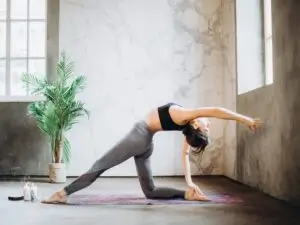You can activate your inner creative potential with a graceful yet holding stance. Dancers Pose is of those positions that appear spectacular to everyone, yet it goes well beyond superficial appearances. Your musculature, attention, and balance are all strengthened by this posture. The position can be scary to undertake. It is because there are so many moving parts, especially for more inexperienced learners.
Dancers Pose
The Sanskrit term for “the dancer’s position” is “Natarajasana.” It is the “King Dancing Stance” or the “Master of the Dance Pose” in mainstream culture. It bears the name Nata-Raja after Lord Shiva, the Master of Dance. Even in the depths of calamity, Lord Shiva found solace in dance. Similarly to this, practicing yoga exercises aids in relaxing the mind. One can achieve equilibrium and peace during a thunderstorm.
Preparation for Dancers Pose
Leg and torso toughness:
Maintaining the position helps to build core and leg endurance. It can be with the warrior, triangle form, stretched side angle, boat pose, and board.
Flexible back:
It is advantageous to have a spine. Stretching like the seated and standing advanced bend, the cobra position, and larvae posture are beneficial.
Achieving stability
Equilibrium and concentration are crucial. Practice basic yoga poses like squats, the eagle stance, and the tree form. You’ll feel more at ease in your posture with better leg symmetry. Take breaths and focus your attention in front of you. It is for improved concentration. The practice of breathing exercises and yoga will also help you better.
Tips and Tricks for Dancers Pose
Ground Deep In Your Toe
Firmly press down on your foot’s four edges. Try to detect your foot’s shape. You will remain more stable in this stance if you do it. It works because our toes, ankles, and associated leg tendons will distribute the weight of our body.
Set a Firm Platform
Your standing leg should be in and without being locked. Strengthen your coordination and support your knee. Use the muscles in your legs. It is such as the quadriceps, thighs, and lower leg. To do this, visualize sensing your standing leg’s kneecap rise higher. It will instantly contract your upper core muscles. Additionally, you can get ready for this by building up your strength.
Activate the chest
Opening up through the chest prevents squeezing the vertebrae. It is as you lean forth and enter the Dancer pose’s back bend. Maintain your shoulders lower and away from your ears while keeping a raised chest.
Concentrate on making a “U”-shaped yoga pose.
Instead of bending your back into a V, try to move it into a smooth U. You can prevent spinal compression by doing it. If you ever experience any pain or tightness, relax out of the stance. Since every part of our limbs is interconnected, lengthening the nearby region will deepen our back bend.
Keep calm and relax in it.
Try not to think about how the posture appears and refrain from comparing your Dancer’s pose. Always be aware of your limitations as a human being. You may acquire whatever position look you like with practice and perseverance.
Steps to do Dancers Pose
- Start in the mountain.
- Put pressure on your right foot and start to move.
- Get the left ankle to move near your glutes on the left flank. Bend the left knee down under you.
- Grab the inside ankle of your left foot with your left hand extended backward. You can utilize a strap by wrapping it over the base of your left shoe. Hold it with your left hand if this is too difficult to attain.
- Raise your right hand, which is the opposite hand at the top.
- To maintain your equilibrium and your eyes, choose a clearer vision.
- To maintain balance, ground yourself with your grounded foot and engage your abs.
- Lift the right foot while simultaneously starting to lean your body inward.
- Get your back thigh level to the floor, and raise the trailing leg. It is as high as is appropriate for you.
- Pause between breaths. Come out of the stance gradually to relax. Return to the Mountain pose by lowering your back foot.
Benefits of Dancers Pose
They are the following:
- It improves reflexes, bodily attention, stability, and concentration. It is a sense of where your body sits and moves in space.
- It develops self-assurance, tolerance, and stamina.
- It increases the standing leg’s ankle, hip, and thigh as the abdomen.
- It stretches the shin and thigh of the lifted leg as the chest, shoulders, and buttocks.
- Expand the chest and shoulders and strengthen the muscles. It surrounds the spine yoga may eventually improve form.
- It may help absorption by toning the abdominal organs and widening the belly.
Variations with Dancers Pose
Position of a Dancer Holding a Strap
You probably need to build lower back and arm movement. It is if you find it hard to raise your leg far behind you. Use a yoga strap to practice in this situation. With both palms next to you, put the yoga belt over your foot or ankle. It is so that it comes towards you over your head. Keep your arms behind your upper spine, and move your hands down the chain. It is while raising your arms and turning your elbows upward. Naturally, you will elevate your rear foot and leg as you slide your hand up. Pause when you reach a suitable length.
Seize a chair or a fence.
When you begin, keep appropriate alignment and balance in this position. Take a chair or a wall to develop your confidence, steadiness, and posture. Grasp onto the chair with the outstretched arm. It is while standing in front of a wall. By doing this, you’ll be able to stretch out longer without losing your equilibrium. Just be careful not to overuse your arm. Your standing leg should continue to carry most of the burden.
Final Words
Dancers Pose is one of those poses that appear spectacular to all. Yet its true worth goes well beyond superficial appearances. Mastering the posture can be anything but elegant. It is because it calls for a lot of tolerance, adaptability, tenacity, and equilibrium

